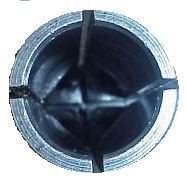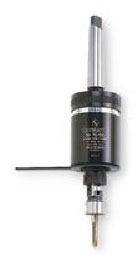Hand Tapping on a Drill Press
| Tapping by hand on a drill press is usually accomplished by drilling the part with a tap drill, then placing a 60-degree straight shank center, or spring center (Figure 1), in the drill chuck. |
|
|
The tap, in a tap wrench, is placed in the hole to be tapped and aligned by placing the center in the center hole of the tap or the tap wrench. By applying pressure to the center while turning the tap, the internal thread is cut square to the workpiece (Figure 2). Figure 2 Hand tapping |
 |
Machine Tapping on a Radial Drill Press
| Tapping on a radial drill press is accomplished by either placing the tap in the tap driver (Figure 3) or in a drill chuck (Figure 4). A relatively slow speed is used to tap, and when the tap is through far enough, the spindle clutch is reversed and the tap is backed out. As the tap is being backed out, maintain a light upward pressure to keep the tap from destroying the first two or three threads. | |
|
|
|
Cutting Speeds for Machine Tapping
There are many variables that must be considered when machine tapping. Selecting cutting speeds for tapping is not done as easily as it is in other machining operations. The best and most efficient cutting speeds for tapping are selected by keeping in mind these factors:
- Material to be tapped
- Length of the hole
- Length of the chamfer at the top of the hole and the length of the chamfer on the tap
- Pitch of the thread
- Percentage of full thread to be cut
- Cutting fluid to be used
- Sensitivity and rigidity of the machine
For example, cutting speeds must be lowered as the depth of the hole is increased because of chip evacuation problems, and because of the intermittent flow of cutting fluids. Taps with large starting chamfers can be run at faster cutting speeds; however, taps with shorter chamfers can be run faster in deeper holes. Bottoming taps must be run slower than plug taps or taper taps. A slower speed is used on taps that cut a greater percentage of threads. Coarse thread taps must be run slower than taps with a fine pitch. The machinist must exercise judgment when deciding the cutting speed limits as compared to his or her ability to control the machine in order to prevent tap breakage. A table of recommended cutting speeds for tapping is given below; however, the machinist must make adjustments according to the factors that were just discussed.
Table 5 Cutting Speeds for Machine Tapping
|
|
Cutting Speed, fpm |
|
Cutting Speed, fpm |
|
Low Carbon Steels Up to .25% C Medium Carbon Steels .30 to .60% C Annealed Heat Treated (220 to 280 Bhn) Tool Steels, High Carbon and High-Speed Steel Stainless Steels Gray Cast-Iron Malleable Iron Ferritic Pearlitic Zinc Die Castings |
|
Aluminum Brass Manganese Bronze Phosphor Bronze Naval Brass Monel Metal Tobin Bronze Plastics Thermosetting Hard Rubber Bakelite |
50 to 200 |
Tapping Attachments
|
When tapping is done on a drill press, there must be some way to back the tap out of the hole. Most radial drills are equipped with a reversing spindle. Upright and sensitive drill presses are not usually equipped with spindle reversing capabilities, thus a special attachment for this operation is required. An automatic reversing tapping attachment (Figure 6) has a tapered sleeve that is inserted into the spindle of the drill press. When tapping a hole using a tapping attachment, the tap is lowered into the hole and fed to the proper depth manually. |
|
When the drill press spindle is raised, gears within the tapping attachment are engaged, causing the tapping head to reverse, quickly backing the tap out of the hole. The tapping attachment can also be equipped with adjustable friction drives that stop the rotation of the tap whenever the tapping torque exceeds a pre-set torque limit, thus keeping the tap from breaking.



